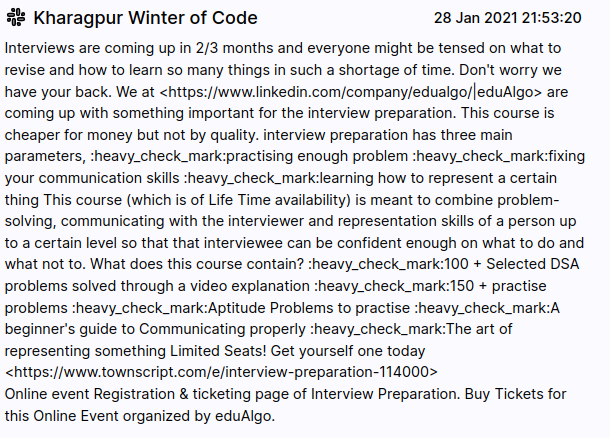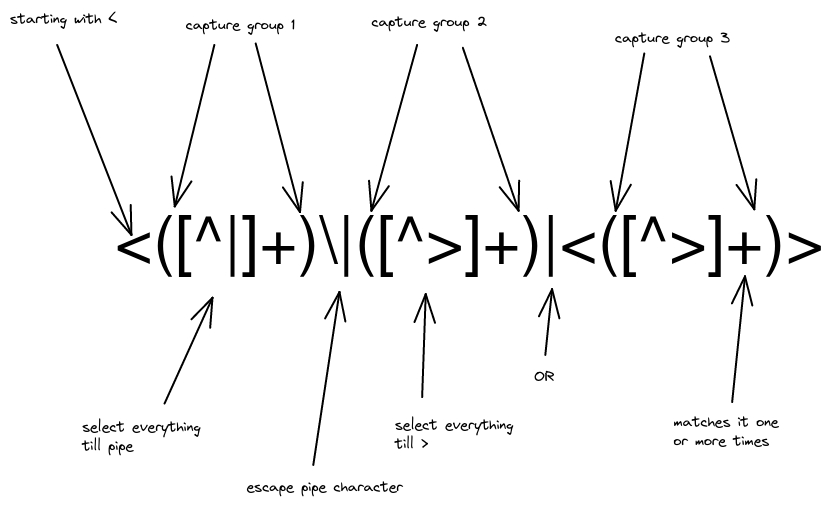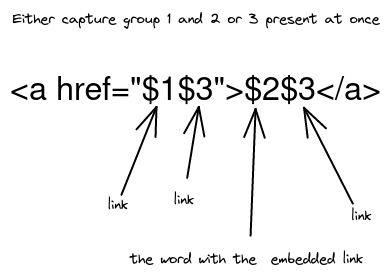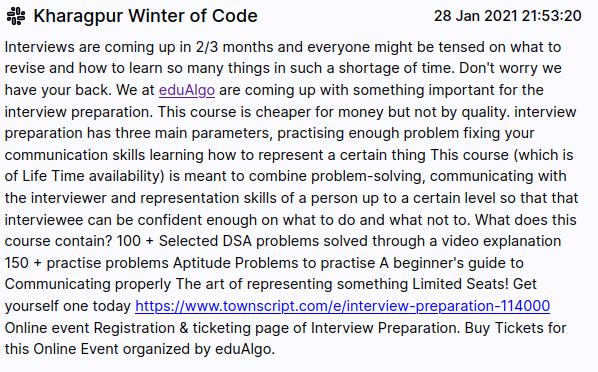Just a few days ago I worked on a search plugin for Neera which would let an user search across multiple public slack workspaces.
This solved two problems:
- One doesn't have to know about a Slack workspace to search through it
- One can search across multiple workspaces concurrently
We (Raghav and I) used Slack's search API after an app was added to that workspace. This post contains how I improved the Slack API response before rendering.
What's the problem exactly?
This is an example of how a single match looks like in the response of the Slack Search API, I removed the parts I didn't need to keep this blog small:
[
{
"type": "message",
"ts": "1611851000.000300",
"blocks": [
{
"type": "rich_text",
"block_id": "rANHC",
"elements": [
{
"type": "rich_text_section",
"elements": [
{
"type": "text",
"text": "Interviews are coming up in 2/3 months and everyone might be tensed on what to revise and how to learn so many things in such a shortage of time.\n\nDon't worry we have your back. We at "
},
{
"type": "link",
"url": "https://www.linkedin.com/company/edualgo/",
"text": "eduAlgo"
},
....
{ "type": "emoji", "name": "heavy_check_mark" },
{
"type": "text",
"text": "The art of representing something\n\nLimited Seats! Get yourself one today\n"
},
]
}
]
}
],
"text": "Interviews are coming up in 2/3 months and everyone might be tensed on what to revise and how to learn so many things in such a shortage of time.\n\nDon't worry we have your back. We at <https://www.linkedin.com/company/edualgo/|eduAlgo> are coming up with something important for the interview preparation. This course is cheaper for money but not by quality.\n\ninterview preparation has three main parameters,\n:heavy_check_mark:practising enough problem\n:heavy_check_mark:fixing your communication skills\n:heavy_check_mark:learning how to represent a certain thing\n\nThis course (which is of Life Time availability) is meant to combine problem-solving, communicating with the interviewer and representation skills of a person up to a certain level so that that interviewee can be confident enough on what to do and what not to.\n\nWhat does this course contain?\n:heavy_check_mark:100 + Selected DSA problems solved through a video explanation\n:heavy_check_mark:150 + practise problems\n:heavy_check_mark:Aptitude Problems to practise\n:heavy_check_mark:A beginner's guide to Communicating properly\n:heavy_check_mark:The art of representing something\n\nLimited Seats! Get yourself one today\n<https://www.townscript.com/e/interview-preparation-114000>",
"permalink": "https://kwoc-koss.slack.com/archives/CQ8MLJ4TD/p1611851000000300",
"no_reactions": true,
"slack_name": "Kharagpur Winter of Code"
}
]
I am concerned with just the text and permalink for now, because all I want is to show the message and take someone to that message on click.
I did the following without putting much thought:
<a href={item.permalink} rel="noreferrer nooepener">
{item.text}
</a>
This is how it looked which brought light to the two of the major issues with using text directly

- Words with embedded links had word after a pipe:
<https://www.linkedin.com/company/edualgo/|eduAlgo>
- Plain Links were in angle brackets but without the pipe
- Emojis had to removed too, they were present by their name
:heavy_check_mark:
Fix how?
I was working on a timeframe, had to get this in a presentable state in an hour or two. Using RegEx to change the links into anchor tags and remove the emojis and later passing the text as innerHTML of a div seemed like the best way.
There was also an array within blocks named elements which had split the text into types like "text", "link" and "emoji". I could have formed the final text using that but thought it would longer and untidier than using RegEx.
Writing RegEx substitutions
- First step to writing RegEx (Regular Expression) is to open a RegEx tester. I like regex101.com.
- Copy a sample text containing the strings you want to substitute or find. The one in the above JSON block is good as it contains both types of links and emojis.
Let's fix the links first
Let's write both types of links and how I want them to look to work:
Before:
<https://www.linkedin.com/company/edualgo/|eduAlgo>
<https://www.townscript.com/e/interview-preparation-114000>
After:
<a href="https://www.linkedin.com/company/edualgo/"> eduAlgo </a>
<a href="https://www.townscript.com/e/interview-preparation-114000">
https://www.townscript.com/e/interview-preparation-114000
</a>
Two cases:
- With pipe
- Select everything after < till a |
- Select the rest, i.e. after | till a >
- Or without a pipe
- Select everything between a < and >

Substitution:

Let's remove the emojis now
Select everything between two colons that's it, right? Nope. Consider this case:
... :heavy_tick_mark:This blog is getting longer than expected :heavey_tick_mark: ....
One can say that there are two strings "heavy_tick_mark" inside colons but there is also one string "This blog is getting longer than expected" inside two colons.
So we only want the strings inside colons that don't contain any spaces. I wrote this for doing the same, notice the space after ^ and before :
/:[^ :]+:/gm
Now, insert the text into the div
<div dangerouslySetInterHTML={{ __html: item.text }}></div>
The results
